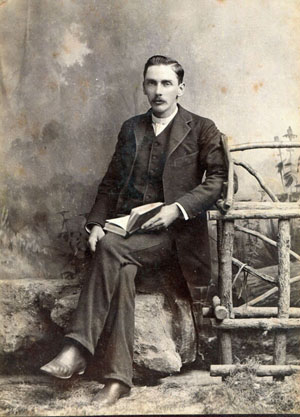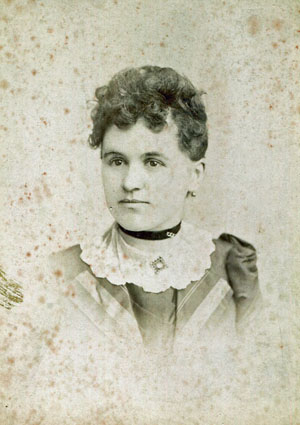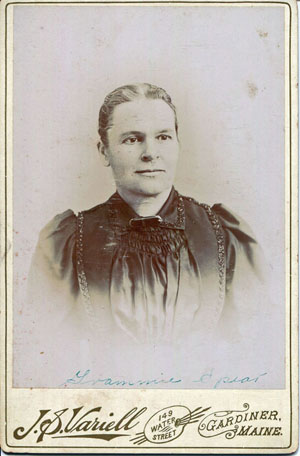|
In the 1880s, education in rural Maine was dominated by many small, almost neighborhood, primary schools run by town school boards. Students attended or not depending on how their parents felt about education. Grading by age was not common so a teacher would most likely have a dozen or so students between five and fifteen years of age, taught all together in one room.
Secondary education was usually in private schools supported by tuition. Public secondary schools were just beginning to make an appearance late in the decade. The participation in secondary education was mainly limited to students contemplating college.
Miles Henry Powers Dustin began his formal education in the schoolhouse at the Potters corner school in Litchfield Maine. He graduated from Litchfield Academy where he excelled as a student, to the extent that he was teaching classes of younger students before he graduated. He intended to attend Bates College but his fatherís poor health required him to stay around home. He taught at the academy for a time after graduation and then at other country schools including the brick school at Potters Corner in Litchfield near the Dustin farm. In 1886, at the age of 20, was appointed to the school board of Litchfield.
Teaching in country schools was not a full time job. There was a summer session while crops were growing and a winter session between harvest and planting, of about two months each. Following the tradition of carpentry in his family Miles became a skilled designer and built homes and farm buildings during the off times.
Leander and Harriet (Hattie) Spear of West Gardiner Maine had a daughter named Annie, born on January 25, 1870. In 1882 at age 12 she started secondary school at the Litchfield Academy. At the age of 16 she graduated with highest honors. This kind of academic achievement attracted the attention of Miles Dustin. Some time after Annie Spearís graduation he visited the Spears and asked permission to court her. Hattie Spear knew a good catch when she saw one so permission was granted.
So Miles called on Annie. She was not interested. Having not reached her seventeenth birthday she thought Miles was too old. He asked her out again in 1887 with the same result, and again in 1888. In the spring of 1899 she apparently either decided Miles wasnít as much older then she as she had thought or that his tenacity deserved some kind of reward. In any event they began to keep company. They were married in April of 1891.
 |
 |
| Miles |
Annie |
Miles and Annie moved into the new house Miles built by the edge of the lake at the foot of Oak Hill. Miles continued his teaching duties and building but found time to educate himself on subjects that interested him. In 1895 Miles became the superintendent of schools for Litchfield and held that post for 12 years.
Miles and Annie had four children:
Genevieve Mertelle Dustin, 3/9/1892, Litchfield, ME
Clifton Henry Dustin 10/5/1893, Litchfield, ME
Cecil Calvert Dustin 12/26/1894, Litchfield, ME
Winona Marie Dustin 11/16/1897, Litchfield, ME
Miles and Annie insisted on the best education possible for their children including a lot of tutoring at home. Miles also guided their education at school as he continued to teach in the brick school at Potters Corner. One of his students who also became a teacher at that school provided a list of the students included in a photo of the school in about 1900. Among those named were the three eldest Dustin children.
One of the interests that Miles had was city planning. As usual he researched the topic thoroughly and decided that New York City was a prime example. In 1902 he travelled to that city to talk to city engineers about how utilities like water, gas, electric power, water and waste removal were handled.
While in New York he was shown the work on the new underground railway route, which was an excellent example of good planning. The disruption of surface traffic was minimal. The traffic on the surface streets though was a chaotic mix of trolley cars, pedestrians, horse drawn vehicles and even a few horseless carriages. There was not any traffic control but self preservation.
Wondering what would happen when thousands of the new motor cars were added to the mix, Miles returned home to work on organizing traffic flow. In 1903 he returned to New York to present an idea he had to improve safety and efficiency at intersections to some of the engineers he met on his previous trip. The Columbus Circle was constructed on the basis of his suggestions and opened in 1905.
In early January 1906 Annie began having momentary lapses in consciousness. Not fainting spells exactly. She would suddenly fall silent but remain erect if standing. In a minute or so she would again become aware of her surroundings. This condition continued for nearly a month, then disappeared. In March she had problems with her balance and fell frequently.
Her mother Hattie, known as Grammy Spear, moved in assumed the mother role in the household so that the eldest daughter, Genie, could concentrate on her studies rather than being burdened with the housework.
 |
| Grammy Spear about 1870 |
By the summer of 1907 Miles decided to move to a bigger city where more medical help was available for Annie. He found that Rochester, NH was looking for a new superintendent of schools so he applied for the job and was invited to come for an interview.
When Miles arrived in Rochester he happened upon the site of the construction of the new city hall/opera house. The construction supervisor was loudly complaining that he could not find anyone who could follow the plans and finish a job on time. Miles told him that he could not only follow plans but draw them up as well. At the end of the conversation the construction boss offered Miles a job and he accepted. Miles moved his family to Rochester later that year.
Annieís condition continued to worsen slowly. In July of 1908 she became bedridden. Grammy Spear was still helping but Miles hired a full time nurse for Annie. Grammy Spear returned to West Gardiner in November of 1908. In April of 1909 Annie died.
Her mother and father came from Litchfield for the funeral and remained until Genie graduated from high school in June. A few weeks later Miles brought her to the Spear house in Litchfield Maine for the summer, an excursion she repeated in 1910 and 1911. She spent the rest of each year in Rochester. In 1913 Genie married Delmar Small of Litchfield, one of her schoolmates at the brick school at the Potters Corner section of Litchfield.
Miles quickly gained a reputation as a builder whose estimates were fair and judgment was sound. He had all the building work he could handle.
In 1913 Miles became acquainted with a young woman of 25 from Salem, NH named Margaret McPhee. Margaret was a teacher recently moved to Rochester to teach in the school there. They became friends and married in 1916. On March 10, 1917 Miles and Margaret had a daughter Hannah Dustin. Tragically Hannah died young at age 7 during surgery.
Miles became one of the leading citizens of Rochester as well as a builder much in demand in the city. He served on the school board for 18 years, the city council for 3 years and 12 years in the New Hampshire state legislature. Near the end of his legislative career, Margaret was also elected to the legislature and they became the first husband and wife team in the nation to serve in a state legislative body.
Miles lived to become well acquainted with most of his great grandchildren and died on June 6, 1960. Margaret died in November 1968.
|




